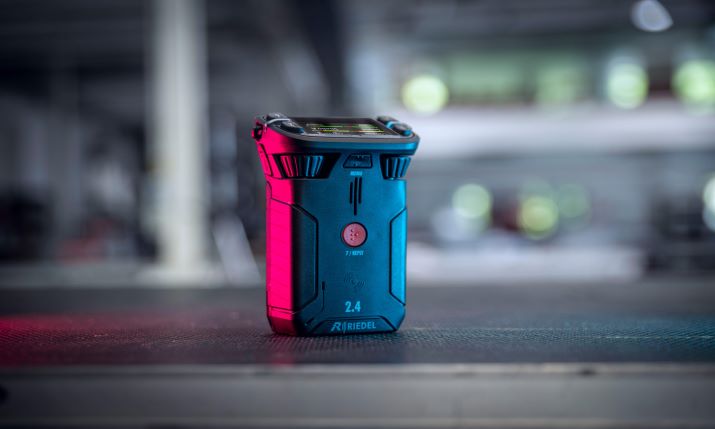Riedel Unveils Bolero 2.4 GHz at IBC2022

Riedel’s new Bolero 2.4 beltpack
Celebrating the fifth anniversary of the state-of-the-art wireless intercom system Bolero, Riedel Communications unveiled Bolero 2.4 GHz at IBC2022.
While Bolero has met success for taking intercoms away from the often congested 2.4Ghz spectrum to the 1.9GHz DECT band, the company is using a combination of technologies to make 2.4GHz a possibility for sports broadcasters, with the combination of RF diversity, a real time processing DSP engine for multi-path reflection suppression for 2.4GHz, plus a multi retransmit mechanism on top.
Jake Dodson, executive director of product management at Riedel, said from the show floor: “Bolero 2.4GHz allows OBs to move across regions, unconstrained by DECT frequencies. While DECT 1.9GHz is a global standard, you can’t use it in places like China or South Korea. 2.4GHz before never had the stability; you’d have congestion problems in stadiums or other close environments with more interference as it’s close to WiFi. Not now.”
Instead of Bolero’s standard DECT band, this new iteration operates on the 2.4 GHz band, allowing customers in regions where DECT carrier frequencies are either limited or unavailable — such as China, India, and South Korea — to profit from Bolero’s versatility, reliability, and unrivalled feature set in navigating difficult RF environments.
“Having won both the DECT Award and Red Dot Award, the Bolero system has shown itself to be highly intelligible, efficient, and resistant to multipath reflections,” said Wolfgang Fritz, senior product manager, Riedel Communications. “Now, compared with other 2.4 GHz wireless intercoms, Bolero 2.4 GHz has double the operational range and supports more than twice the number of beltpacks per antenna. We are eager to see how our internationally operating customers like touring, cruise ship, or OB production companies can finally use the same globally available frequency range to work across various regions, thereby vastly improving team communication.”
Bolero 2.4 GHz uses a practically identical feature set and offers the same three network modes as the DECT version: Integrated, Standalone Link, and Standalone 2110 (AES67). The 2.4 GHz band limits use to eight beltpacks per antenna instead of 10, but allows for connectivity anywhere, with just one “Global” region for 2.4 GHz antennas. The 2.4 GHz iteration also comes with Bolero’s high-clarity voice codec and its unrivalled multipath tolerant receiver (ADR) technology adapted to 2.4 GHz, allowing the system to continuously adapt to changing RF reflection environments. With near field communication (NFC) touch-and-go beltpack registration; an ergonomic, robust beltpack design; and three modes as beltpack, desktop key panel, or walkie-talkie, Bolero 2.4 GHz is just as easy to use, sleek, and versatile.
While Bolero 2.4 GHz was developed primarily for Riedel’s international customers, regions in the United States where the number of DECT carrier frequencies are limited can benefit from a hybrid 2.4 GHz and DECT system, enabling the creation of massive installations with unprecedented number of users in a limited space.
